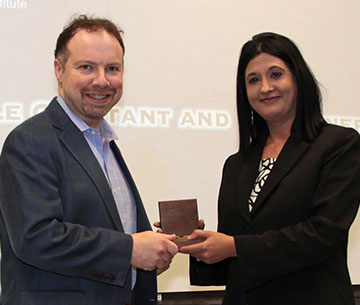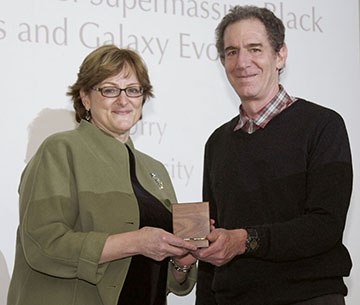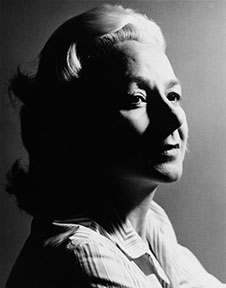Antoinette de Vaucouleurs Lectureship and Medal
This memorial lectureship was established in 1990-91 to honor the late University of Texas Astronomy Department Astronomer Antoinette de Vaucouleurs. The prize was endowed by private gifts, including the Board of Visitors, and matching funds from the Board of Regents of the University of Texas and is awarded annually to an "outstanding astronomer in recognition of a lifetime of dedication to astronomy". The recipient visits the Astronomy Department for a few days and gives both a science seminar as well as a public-level talk and receives a $5000 honorarium and medal.
 |
 |
 |
| Neta A. Bahcall and Dept. Chair Shardha Jogee (2018) | Adam G. Riess and Dept. Chair Shardha Jogee (2015) | C. Megan Urry and Dept. Chair Dan Jaffe (2014) |
List of Recipients
| 1990-1991 | E. Margaret Burbidge |
| 1992-1993 | Edwin E. Salpeter |
| 1993-1994 | Vera C. Rubin |
| 1994-1995 | Donald E. Osterbrock |
| 1995-1996 | P. James I. Peebles |
| 1996-1997 | Sandra M. Faber |
| 1997-1998 | Bohdan Paczynski |
| 1998-1999 | Peter Goldreich |
| 1999-2000 | Reinhard Genzel |
| 2002-2003 | Frank Shu |
| 2003-2004 | Ken Freeman |
| 2007-2008 | John Mather |
| 2008-2009 | Christopher McKee |
| 2009-2010 | Rashid Sunyaev |
| 2010-2011 | Robert Kraft |
| 2011-2012 | Wendy L. Freedman |
| 2013-2014 | Robert C. Kennicutt, Jr. |
| 2014-2015 | C. Megan Urry |
| 2015-2016 | Adam G. Riess |
| 2018-2019 | Neta A. Bahcall |
| 2019-2020 | Judith L. Pipher (unable to visit due to COVID-19) |

Antoinette de Vaucouleurs
1921-1987
Antoinette de Vaucouleurs, an atronomer in the Astronomy Department of the University of Texas at Austin for 25 years (1961-1986), established an international reputation for her work in astronomy at a time when few women worked in that field. Born Antoinette Piétra on November 14, 1921 in Paris, France, she married Gérard de Vaucouleurs on October 31, 1944 and began a life-long partnership in marriage and astronomical research. She studied mathematics, physics, and astronomy at the Sorbonne (1944-1948) and first worked in laboratory spectroscopy at the Paris Institute of Astro-physics (1948-1949). While in England (1950-1951), she took part as a voluntary assistant in the parallax program at the University of London Mill Hill Observatory, when Margaret Burbidge was acting director.
After the de Vaucouleurs moved to Australia in 1951, Antoinette worked for five years at the Commonwealth Observatory on Mount Stromlo, near Canberra, as an assistant to the Director, Professor R. Woolley. The main programs were initially the spectrophotometry of southern bright stars and of the planet Mars. She then produced the first quantitiative spectral and luminosity classification of several hundred B, A, and F type stars and measured the equivalent width of the K line of ionized calcium in many southern stars of astrophysical interest. Antoinette also worked with her husband on the first quantitative spectral population analysis of a galaxy (the bar of the Large Magellanic Cloud) from the strength of its absorption lines.
When the couple moved to the United States in 1957 at the invitation of Lowell Observatory in Flagstaff, Arizona (1957-1958), Antoinette helped her husband with the reduction of the first photoelectric photometry of galaxies in Harold Johnson's U,B,V system. During this work she first noticed in 1958 that the magnitudes of the central parts of several Seyfert galaxies differed perceptibly over a one-month interval — the first detection of variability in galactic nuclei — and her suspicions were verified ten years later when the variations were firmly established by others.
While at Harvard Observatory in Cambridge, Massachusetts (1958-1960), Antoinette made a major contribution to a revision of the Harvard Catalogue of Galaxies of Harlow Shapley and Adelaide Ames (1932), a fifteen-year project on which she and her husband had worked since 1949. This culminated in the (First) Reference Catalogue of Bright Galaxies published by the University of Texas Press in 1964 after the couple moved to UT Austin to join the newly formed Department of Astronomy, where she was an astronomer for 25 years (1961-1986), until illness forced her to retire. During this time she participated in nearly all the extragalactic research of her husband, particularly in the radial velocity surveys with the 205-cm (82-inch) Struve reflector at McDonald Observatory (1960-1978) and the photoelectric photometry of bright galaxies with the 90-cm (36-inch) reflector (1960-1982).
She was also a co-author of the Second Reference Catalogue (1976) and was working on the much enlarged Third Reference Catalogue (published by Springer-Verlag in 1991) when she heard the dreadful diagnosis of cancer of the bone marrow (multiple myeloma) in October 1986. Characteristically, her very first reaction was that she hoped to have enough time left to finish her share of the collective work. Although in pain, she was able to work on it until June 1987, just ten weeks before she died on August 29, 1987.
In her 40 years of professional activity, she was the author or co-author of more than 60 research papers and galaxy catalogues which have been extensively used by astronomers. As a lasting testimony of the love she had inspired in those who knew her and of the high esteem in which her work was held by the astronomical community around the world, her friends and colleagues, and the Board of Regents of The University of Texas, endowed the Antoinette de Vaucouleurs Memorial Lectureship and Medal to be awarded each year to an outstanding astronomer in recognition of a lifetime of dedication to astronomy.




